ᴏɴᴇꜱ ᴀɴᴅ ᴢᴇʀᴏᴇꜱ
:・゚✧:・.☽˚。・゚✧:・.:
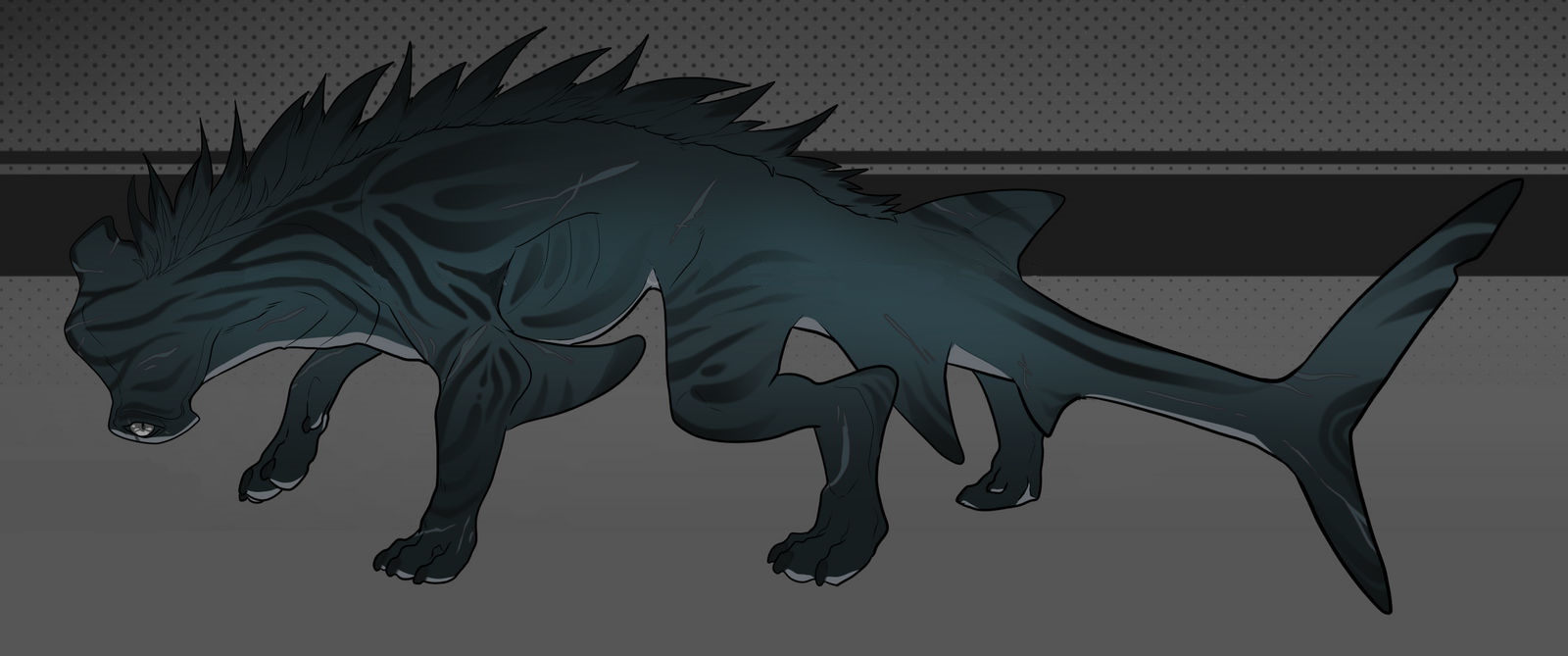
Pictured: A fully-grown Ithorian Karnissadon.

Pictured: A fully-grown Ithorian Karnissadon.
OUT OF CHARACTER INFORMATION
- Intent: To provide an adorably dangerous semi-aquatic creature.
- Image Credit: x x x x x x
- Canon: n/a
- Permissions: n/a
- Links: n/a
GENERAL INFORMATION
- Name: Karnissadon
- Designation: Semi-Sentient
- Origins: Karkaris
- Average Lifespan: 60-200~
- Estimated Population: Scattered
- Description: Many Karnissadon share the same general traits — they're amphibious-aquatic quadrupeds, adorned with sharp claws on all four feet and several rows of serrated teeth. Beneath their paws are pads, not dissimilar to those of canines. All Karnissadon have a multitude of fins that accompany the length of their tail, as well as a dorsal fin atop the centre of their bodies. Gills are present at either side, allowing them to survive underwater without risk of asphyxiation.
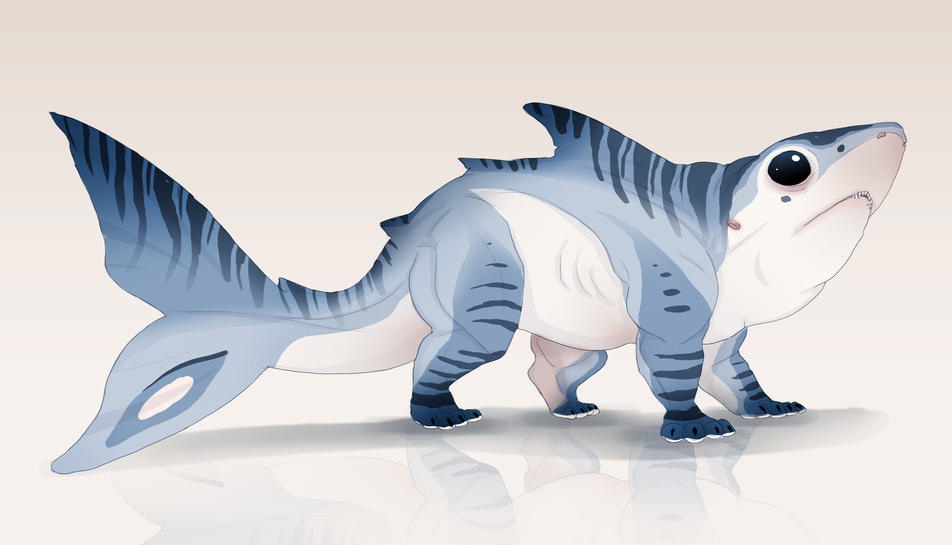
Pictured: An infant Lapis Karnissadon.
PHYSICAL INFORMATION
- Breathes: Type I
- Average Height of Adults: Varies depending on breed — however, adults commonly stand at 1.8m (6 ft) if including their dorsal fin.
- Average Length of Adults: Varies depending on breed — however, adults commonly measure 4.0 m (13 ft).
- Skin color: Varies depending on breed — however, most Karnissadon come in differing shades of blues and browns.
- Hair color: n/a
- Distinctions: There are a plethora of differences among certain breeds. While the most common of Karnissadon tend to grow into a stockier build, certain species retain a more slender physique. Generally, the latter are often on the shorter end in terms of length — the bulkier Karnissadon have been observed to grow much larger, with considerably longer lifespans.
There is little sexual dimorphism between males and females beyond the latter often inching out the former in size, though the differences are largely minimal. Pups are often born plump, and take a good few years to shed their baby fat.
The most curious distinction between Karnissadon species is the texture of their bodies. Generally, most breeds have sleek, smooth skin that are covered by a layer of placoid scales. Some, however, have been seen to grow coats of fur — something that has been linked to the evolution of Karnissadon that spend more time on land, in comparison to their oft seabound counterparts. This process takes an incredibly long time and often decreases the Karnissadon's expected lifespan, as they have to divert bodily resources in order to continuously shed their scales.
- Races: n/a
- Force Sensitivity: Non-Sensitive
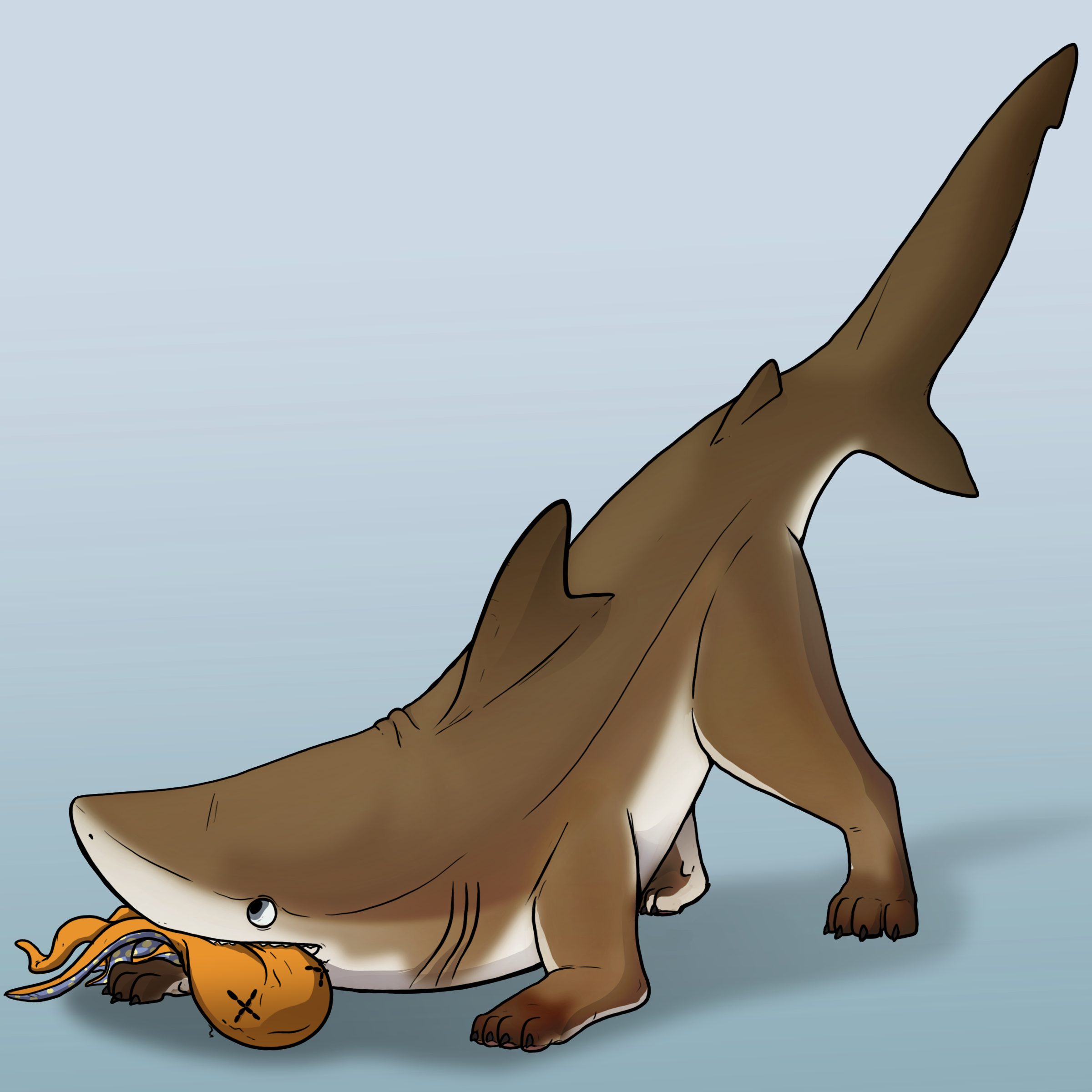
Pictured: An adolescent Sand-Nosed Karnissadon.
:・゚✧:・.☽˚。・゚✧:・.:
Strengths:
- Semi-Aquatic: Karnissadon are perfectly capable of surviving on both land and sea, with a pseudo-chamber of quasi-traditional lungs for oxygen intake above water that seal shut when the Karnissadon is submerged in water — in which its gills are used to extract oxygen.
- Apex Predator: Karnissadon are often at the top of the food chain in many of the ecosystems they live in; particularly those underwater. Their sharp claws and myriad of dagger-like teeth easily prove fatal to squishier organics, making a wild encounter an incredibly dangerous one. Once a Karnissadon sinks its teeth into its prey, it's borderline impossible to pry them off lest a powerful blow is struck to either their nose or their gills. Karnissadon are also rather intelligent, and have been observed to strategize with others of their species in order to eliminate a common enemy.
- Bloodhound: Karnissadon have an excellent sense of smell, having evolved to detect blood from hundreds of meters away. If properly trained and domesticated, they serve as incredibly useful sniffer-dogs for hunting down potential targets that have attempted to flee.
- Structural Sturdiness: Many Karnissadon have incredibly bulky builds, something they're born with and typically keep lest they fall under very specific breeds. Their bodies are considerably dense, allowing them to absorb a lot of blunt force without much damage. Barring a few weak spots such as the aforementioned nose and gills, the standard kick and punch will do little to nothing to a Karnissadon.
- Domestication: Karnissadon pups are deceptively easy to train. Should they be adopted at a young age, they latch onto their carer rather quickly. When domesticated, Karnissadon prove to be incredibly loyal to their owners, and are surprisingly quick learners in most regards.
Weaknesses:
- Fish Out of Water: While still making for formidable foes, Karnissadon are substantially weaker when plucked from their respective ecosystems. There are much bigger and much fiercer creatures in the galaxy than them, and they simply haven't adapted to face against any.
- Face-to-Face: Karnissadon are incredibly lethal predators when up close, but that is the only space wherein they're effective, and cannot deal with an assailant that outranges them. Thus, they're simple to deal with should one keep their distance — a Karnissadon's body offers next to nothing in terms of protection against blasters, making them easy targets. Additionally, even at close ranges, Karnissadon have no means to protect themselves from lightsabers.
- Bloodlust: Surprisingly intelligent creatures for such outwardly beastly appearances, a Karnissadon has the brains to know when it's outmatched and is happy to retreat should it have to. With that being said, a carnal remnant of leftover natural instinct prevents them from using said brains should a Karnissadon taste blood. Upon doing so, it enters a state of frenzy, reverting it into a mindless animal with zero self-preservation skills. They are easy to distract and outsmart, proving vulnerable to bait.
- Force Susceptibility: Despite their intelligence, Karnissadon are vulnerable to Jedi mind tricks. Furthermore, they have no means to shield themselves from the Force; once again making them sitting ducks for the telekinetically inclined.
- Volatile: While easily trained as pups, it proves unfathomably difficult to do so with adults. If a Karnissadon hasn't been domesticated from a young age, it's almost impossible to reason with them, with wild Karnissadon stubbornly refusing to listen. This makes adoption rather tricky if they're adolescents or older. Additionally, domesticated Karnissadon may grow restless if not adequately provided for, and have a record of being difficult to work with should their owners not have properly tamed them as pups. It isn't uncommon for Karnissadon to flat-out kill and eat their owners under stressful conditions.
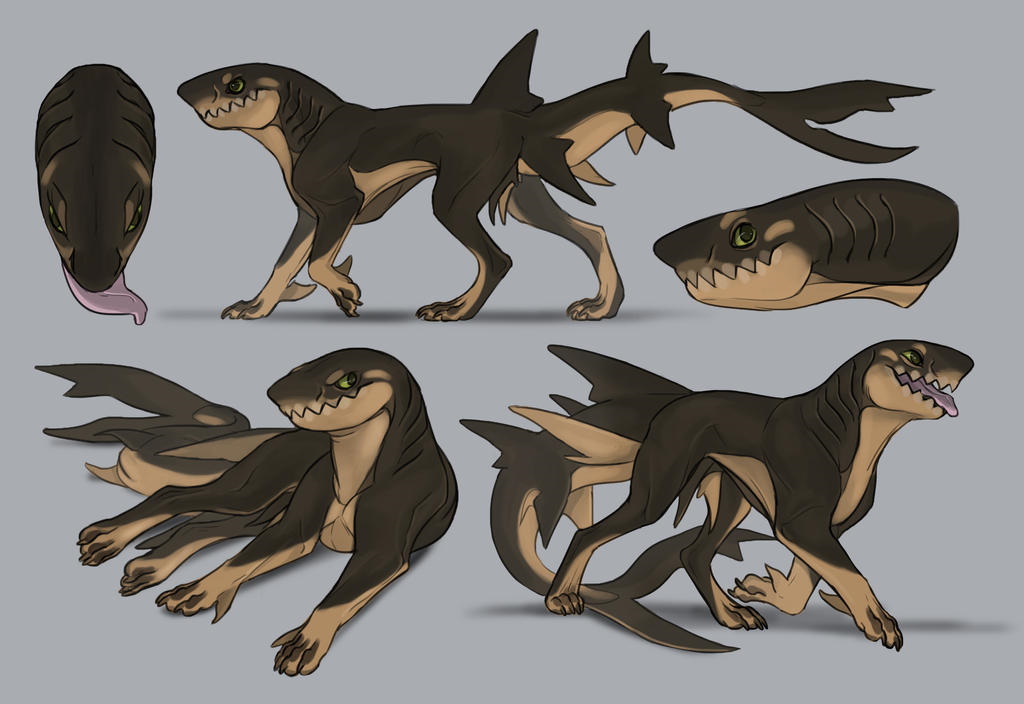
Pictured: An adolescent Traptoothed Karnissadon.
:・゚✧:・.☽˚。・゚✧:・.:
CULTURE
- Diet: Karnissadon are carnivores; their natural diets consist mostly of fish, but frequently prey on small-to-medium sized mammals, reptiles, and unsuspecting seabirds. Having said that, Karnissadon are capable of consuming any array of meats fed to them with minimal risk to their health, which makes hunting on land significantly easier — as well as maintenance when kept as pets.
- Communication: Karnissadon communicate through a series of deep, warbled growls and bellows. When high on alert, they may 'bark' like typical canines, albeit in a much more gargled fashion. They are incapable of speaking Galactic Basic, but pick up on words relatively quickly as pups.
- Technology level: n/a
- Religion/Beliefs: n/a
- General behavior: Wild Karnissadon are — generally — rather vicious and hostile creatures. They are easily provoked and incredibly territorial, guarding their land and/or waters with an unwavering fervor. Karnissadon often hunt on their lonesome and typically live in solitude, though they aren't above forming brief packs if it ensures a successful mating or a kill on a larger animal. They get along fine in groups for the most part, but may be victims of in-fighting if two males seek the same female. Karnissadon are not above cannibalism should one of their pack members die, and will occasionally kill another's young if particularly starved.
Karnissadon have displayed surprisingly adept problem solving skills, noted to have object permanence and an awareness of what is and isn't a reflection, and have even showcased the ability to complete rudimentary puzzles after specific training. They can understand words to an extent, associating them with moods and actions to better decipher what is being said to them. Karnissadon — domesticated ones especially — are incredibly perceptive of the moods of those around them, and have a solid understanding of when something is in distress.
While lone wolves in the wild, domesticated Karnissadon have shown to attach to caretakers if adopted as pups. They make for loyal pets if trained appropriately, though they may still have something of a reckless streak as adolescents. Pet Karnissadon are naturally excitable, but are able to mellow out should they be tought to. As with many species, domesticated Karnisaddon are prone to losing their hunting instincts if raised as pups, and tend to rely on their owners for food.
When excited, Karnissadon may wag their tails and 'dance' by trotting on the spot. They display affection in the form of licking, and enjoy resting atop their owners. If satisfied, their throats produce a deep rumbling sound; while the noise may appear unnerving, its function is virtually identical to a cat's purring.
Should their owners neglect them, Karnissadon grow restless, a deep-seeded anger bubbling away at them until they've reverted into the hostile beasts akin to their untamed counterparts. Karnissadon go through a frequent teething, and if not properly addressed, may unintentionally cause harm to their owners.
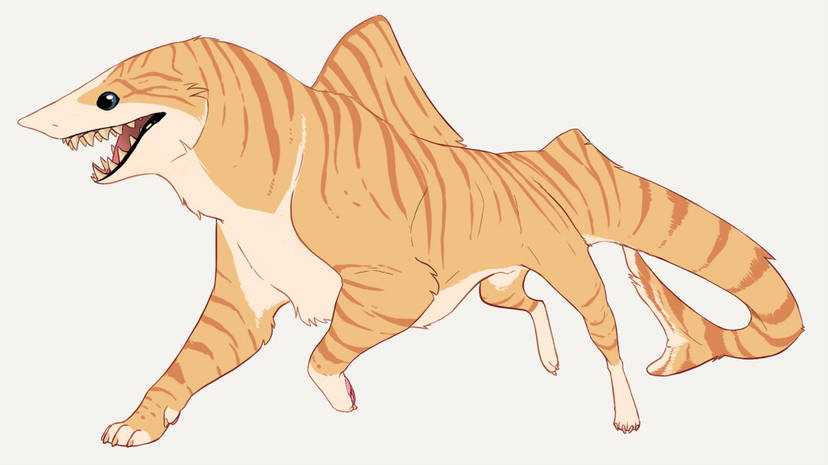
Pictured: A fully-grown Meiloorun Karnissadon.
HISTORICAL INFORMATION
Native to the planet of Karkaris, Karnissadon are distant relatives to the Karkarodon, serving as something of a what-if scenario in the case that the latter never evolved into their anthropomorphized forms. As the Karkarodon specked into humanoid proportions, the feral Karnissadon prioritized taking advantage of the less civilized waters of Karkaris, doubling down on preying on the wildlife neglected by a soon-to-be society. With the quasi-modern era drawing closer, Karnissadon would be treated as icons, deeply tressured by Karkaris' people. Thus, following the introduction of interplanetary travel, they would be imported to other worlds as trophy pets.
With their growingpopularity, Karnissadon became more sought after, catching the interest of terrestrials. Quick to acclimate, the stubby legs of the Karnissadon would grow in attempt to catch up to their fully sentient counterparts. While this had — theoretically — ensured an easier domestication, they proved to be too high maintenance for unsuspecting carers, resulting in several deaths of owners and several more abandonments of pets. Introduced to the local ecosystem of planets they were never designed for, the Karnissadon evolved into apex predators, having fully adapted to a semi-aquatic lifestyle.
In the modern galaxy, Karnissadon are now a relatively common species even outside of Karkaris. Their natural habitats consist primarily of deep oceans, beachfronts, and governing tropics with dense foliage — making planets such as Scarif, Kashyyyk, and Iloh perfect environments for both landloving and seafearing Karnissadon.
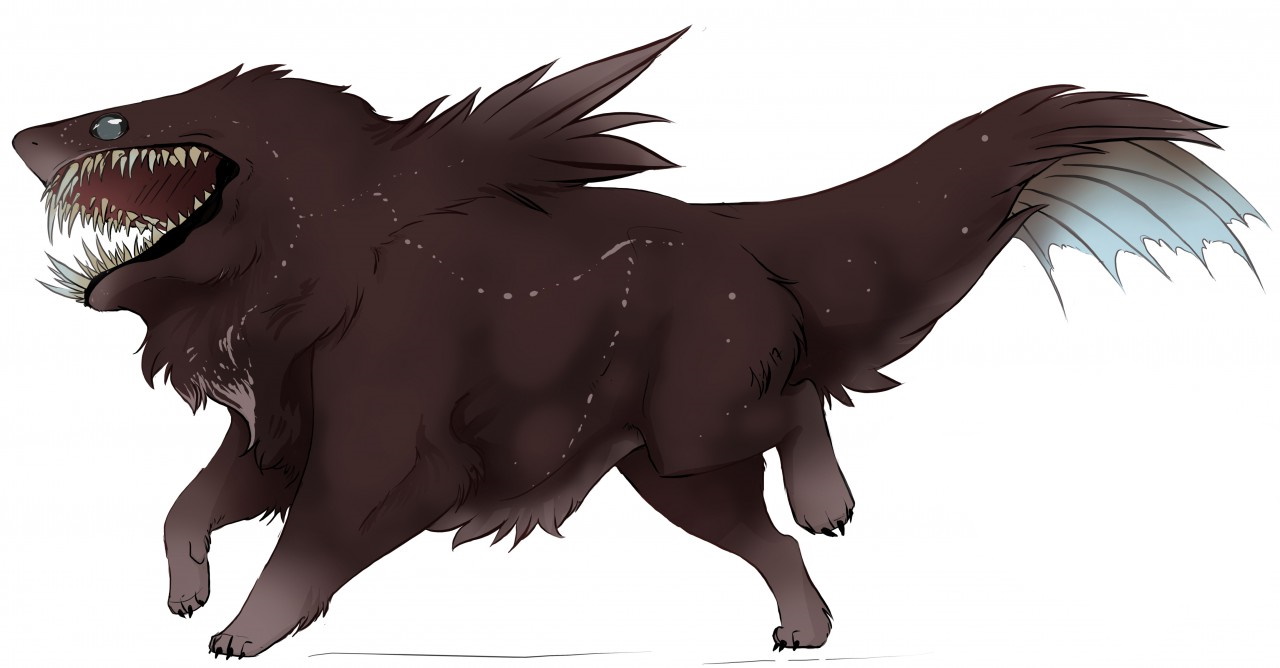
Pictured: A fully-grown Abyssal Karnissadon.
:・゚✧:・.☽˚。・゚✧:・.:
Last edited:








